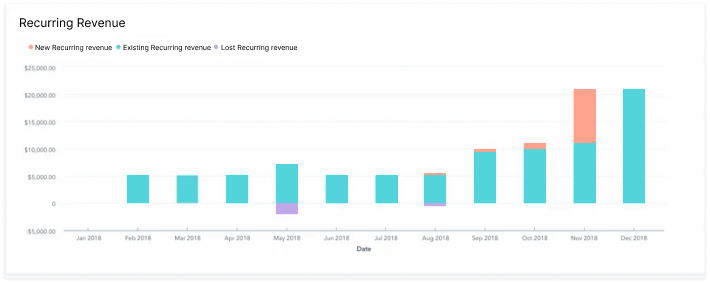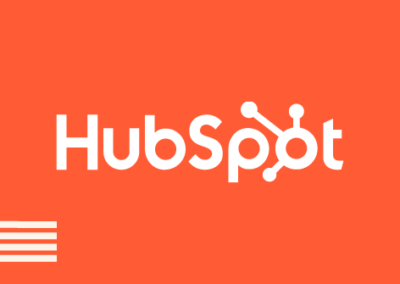The HubSpot Sales Hub is an invaluable tool for B2B companies, offering a wide range of features to optimize and streamline sales operations. One such feature is recurring revenue tracking. In this article, we’ll discuss how recurring revenue tracking can help you gain more sales, its benefits, and how to set it up. Furthermore, we’ll come up with an example and explore how Radiant can assist you in utilizing HubSpot’s features.
What is Recurring Revenue?
Recurring revenue is the revenue of a company that is expected to continue in the future. Unlike one-time sales (like when you buy a computer), recurring revenue is predictable, stable, and can be counted on to occur at regular intervals (this could be a subscription to maintain the computer you bought). However, it’s commonly associated with subscription-based business models, such as software-as-a-service (SaaS) companies, monthly subscription boxes, and membership-based businesses.
Who Tracks Recurring Revenue?
The companies that typically track recurring revenue are:
- Subscription-Based Businesses: Companies that operate on subscription models, like streaming services, SaaS platforms, and magazines, rely heavily on tracking recurring revenue.
- Financial Departments: Within any organization, the finance and accounting teams track recurring revenue to aid in financial forecasting and budgeting.
- Investors and Analysts: Investors and market analysts often track and assess a company’s recurring revenue as it provides insights into the company’s financial stability and future profitability.
- Startups: Many startups, especially in the tech and service sectors, focus on building recurring revenue streams to showcase long-term viability to potential investors.
Why Should You Track It?
There are several reasons why you should track recurring revenue, however, it really depends on your business model, but here are some of the common reasons:
- Predictability: Recurring revenue provides a more predictable and stable cash flow, making financial planning and budgeting more straightforward.
- Valuation: Companies with significant recurring revenue are often valued higher because of the predictable nature of their future earnings.
- Customer Retention: Tracking recurring revenue can give insights into customer satisfaction and loyalty. High recurring revenue indicates high customer retention.
- Operational Efficiency: With a steady stream of income, companies can allocate resources more efficiently and make informed decisions about growth and expansion.
- Investor Appeal: Recurring revenue models are attractive to investors as they indicate a sustainable and potentially scalable business model.
How do You Calculate Recurring Revenue?
To calculate your recurring revenue for a specific period you should:
- Identify All Recurring Revenue Streams: This includes monthly subscriptions, annual memberships, and any other regular income sources.
- Sum Up the Revenue: Add together all the recurring revenue amounts for the period in question (e.g., a month or a quarter).
- Exclude One-Time Payments: Ensure that any one-time sales, special project fees, or non-recurring income sources are not included in the calculation.
From here you have everything you need. Recurring revenue is just the sum of all the revenue that occurs over a period. Therefore, the easiest way to calculate it is to know how much revenue comes back each month and multiply that by the number of months your period is.

Why Recurring Revenue Tracking can help you gain more Sales
Recurring Revenue Tracking is a great feature in today’s competitive sales landscape. As a result, businesses that effectively track this can better understand their customer base, and identify opportunities for growth. Additionally, HubSpot Sales Hub’s robust tracking features empower businesses to make well-informed decisions, ensuring that resources are allocated efficiently.
What are the Benefits of Recurring Revenue Tracking in Correlation to Sales
Incorporating Recurring Revenue Tracking within your HubSpot Sales Hub comes with several benefits that can impact your sales – the benefits include:
- Improved Forecasting: By tracking recurring revenue, you can accurately predict future income, make strategic decisions and set realistic sales targets.
- Enhanced Customer Retention: With better visibility into customer behaviour, you can identify patterns and potential issues, leading to increased customer retention.
- Data-driven Decision-making: Tracking recurring revenue enables you to make data-driven decisions, ensuring that your sales strategies are informed and effective.
A Step-by-Step Guide to set it up
To start tracking your recurring revenue, you’ll first need to create the default recurring revenue deal properties in your HubSpot account:
- Log in to your HubSpot account and go to Reports > Analytics Tools.
- Select Revenue Analytics.
- Click on “Add properties and start tracking.” If this option isn’t available, it means the properties have already been created.
- In the pop-up window, click “Create properties.”
Once you complete these steps, the following recurring revenue properties will be added to your account:
- Recurring Revenue Amount: This represents the total monthly recurring revenue associated with a deal.
- Recurring Revenue Deal Type: This property indicates the type of deal, with available values such as New Business, Renewal, Upgrade, and Downgrade.
- Recurring Revenue Inactive Date: This is the date when the recurring revenue for a specific deal ceases to be collected.
- Recurring Revenue Inactive Reason: This property explains why the recurring revenue for a particular deal is no longer being collected, with available values including Churned, Renewal, Upgrade, and Downgrade.
If you want more information on the topic you can read Hubspot’s own guide: Track Recurring Revenue in Hubspot
An Example where it’s Relevant for a Company
Consider a B2B software company that offers subscription-based services. In order to scale, the company needs to understand its revenue streams and customer behaviour. Implementing recurring revenue tracking within HubSpot Sales Hub allows the company to track key metrics, such as churn rate and average revenue per user. Consequently, this data enables the software company to identify potential issues, such as high churn rates in a specific customer segment, and take proactive measures to address them. Furthermore, the company can leverage the data to make informed decisions about product development, pricing, and sales strategies. Overall, the effective use of recurring revenue tracking equips the software company with valuable insights.
How Radiant can help you Utilize Features within HubSpot
At Radiant, we understand the importance of leveraging HubSpot features effectively, including. Our team is dedicated to helping B2B companies optimize their sales processes and strategies. Furthermore, we provide comprehensive onboarding, training, and support to ensure that you can fully utilize HubSpot to meet your goals. With Radiant’s guidance – contact us here.



